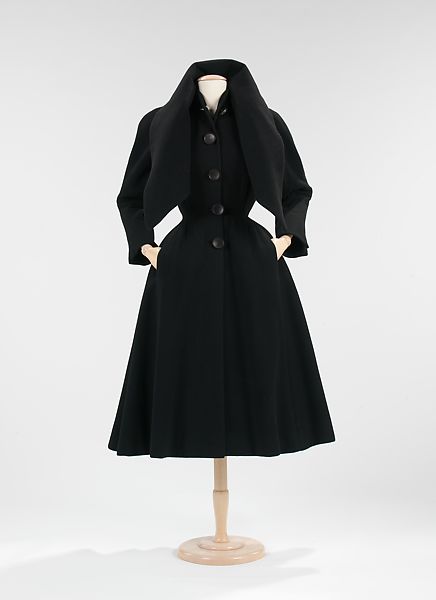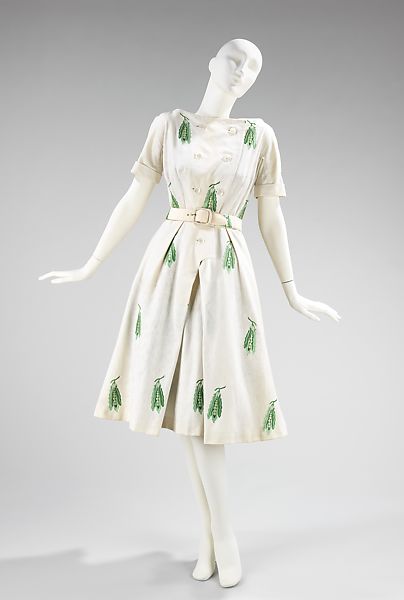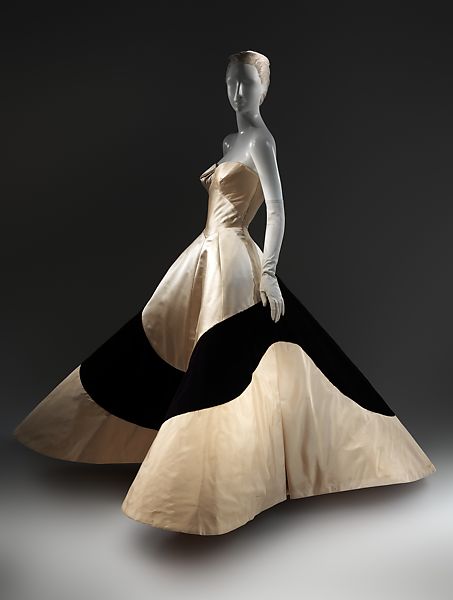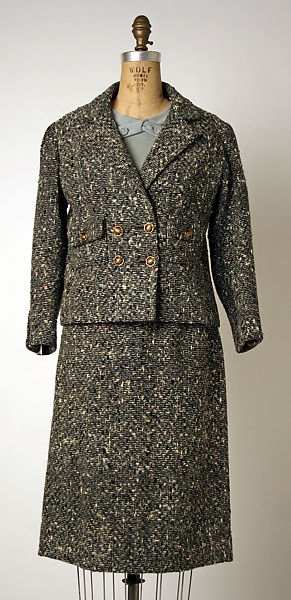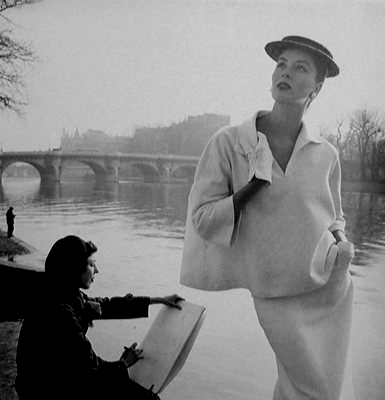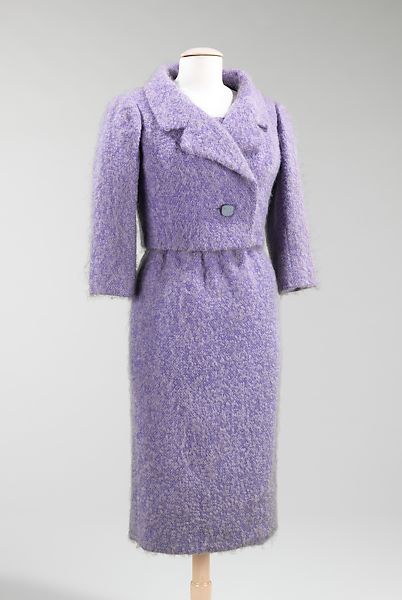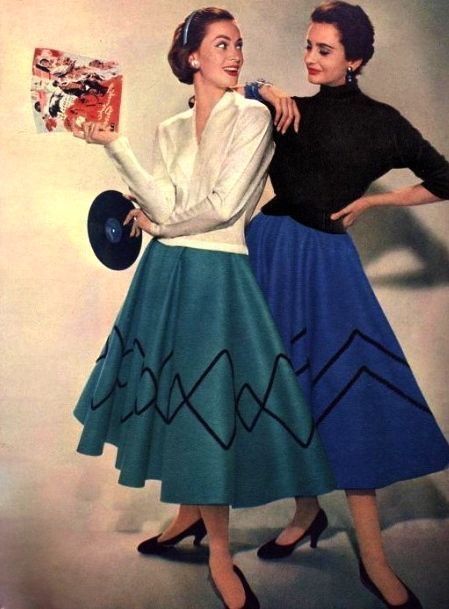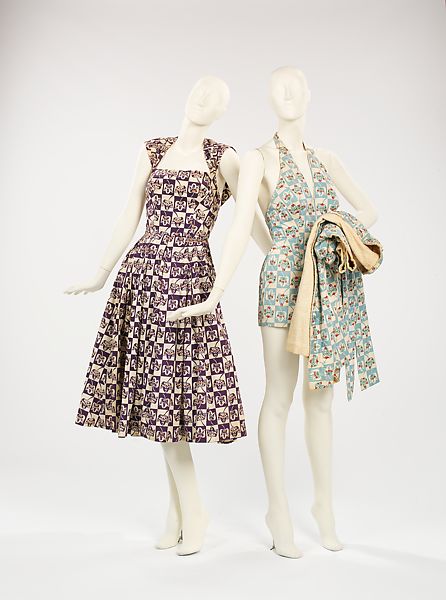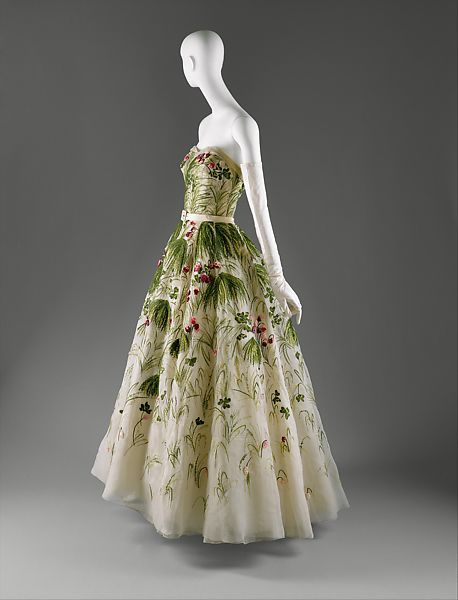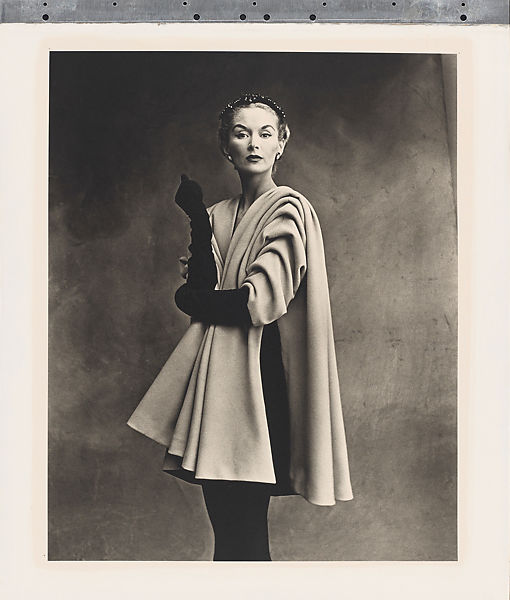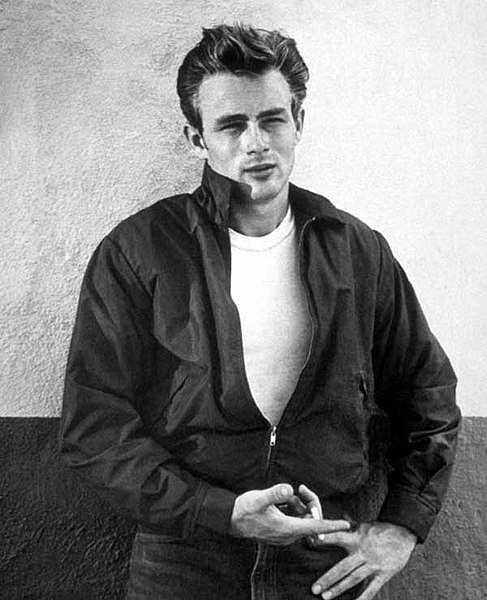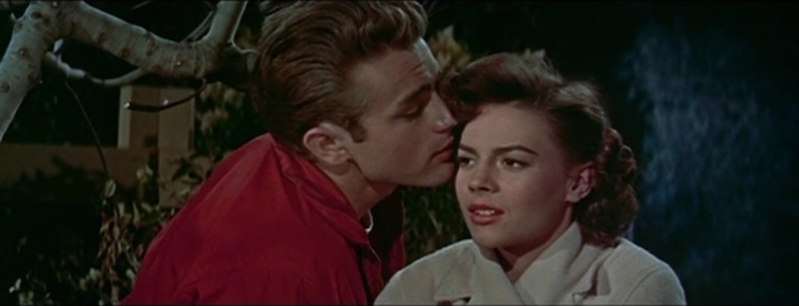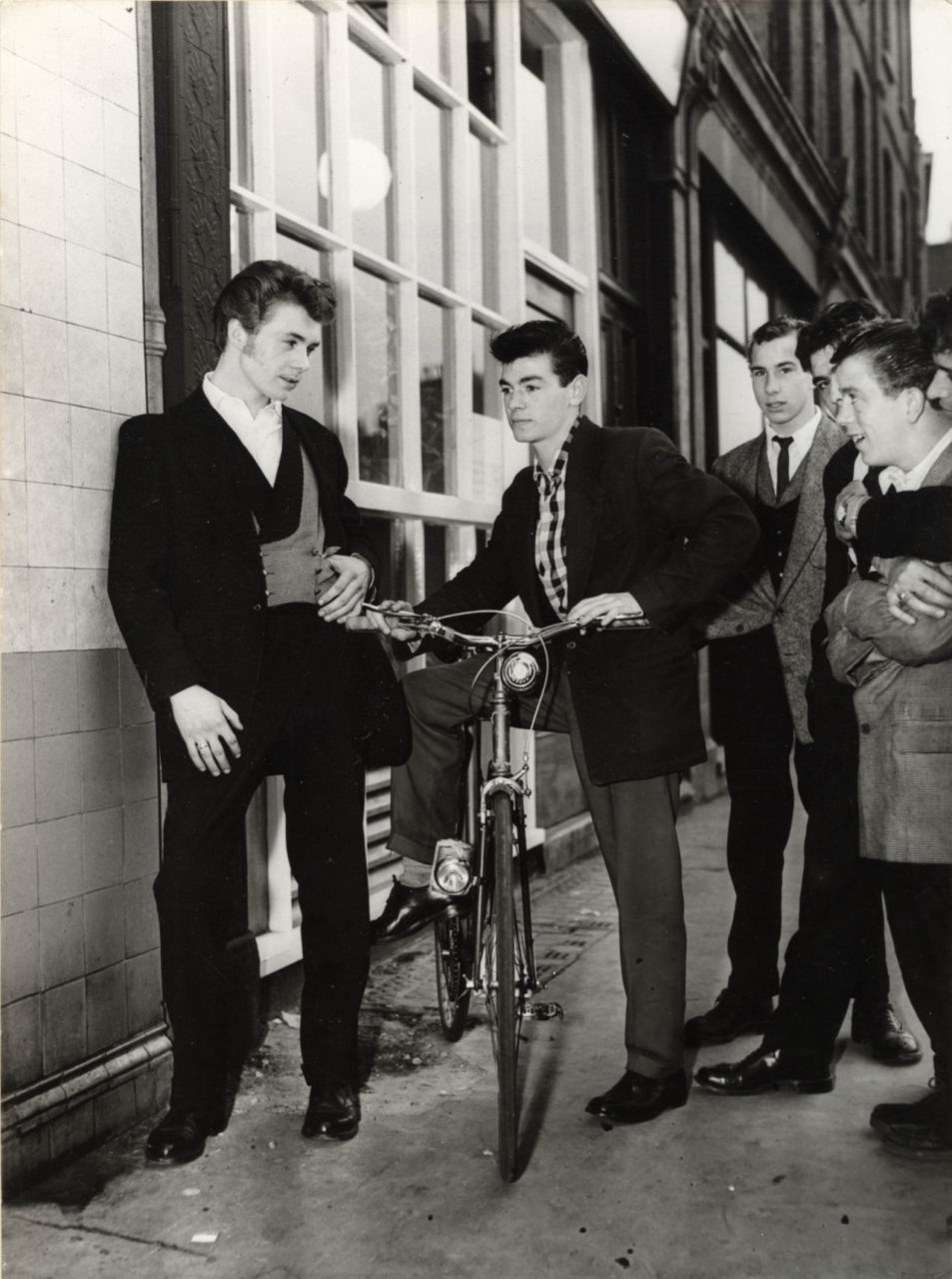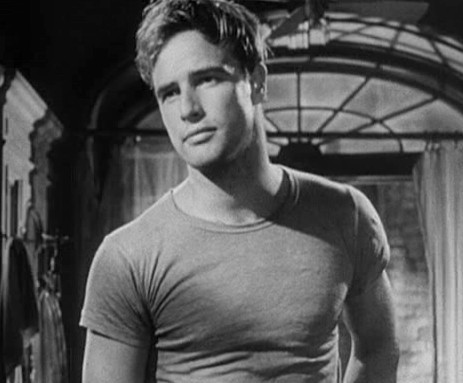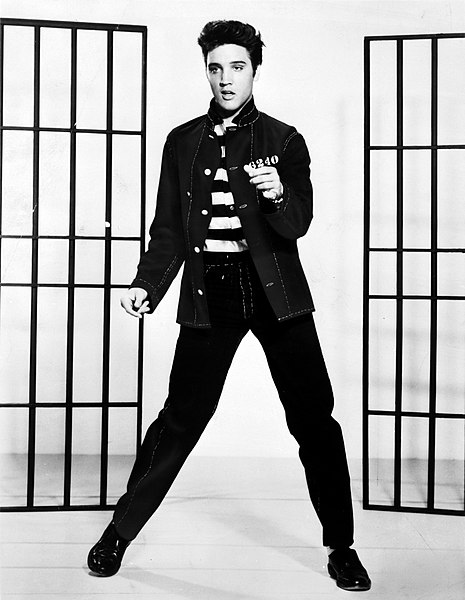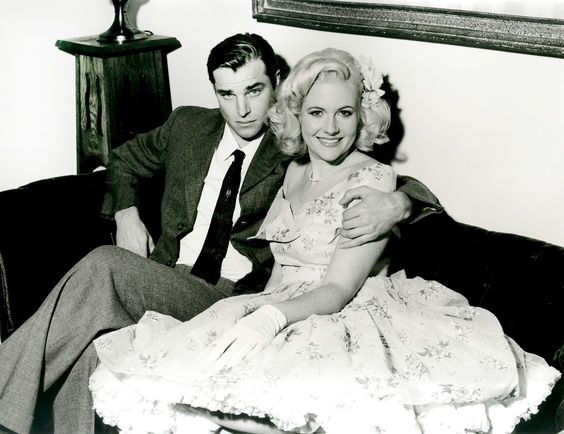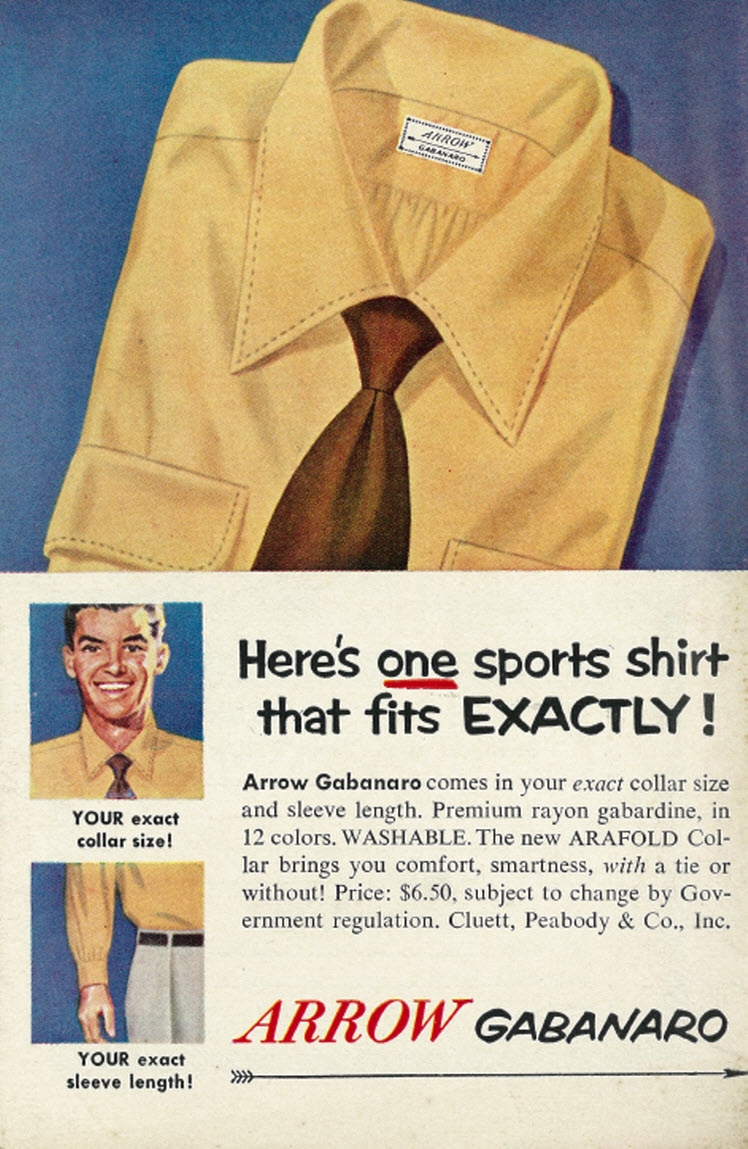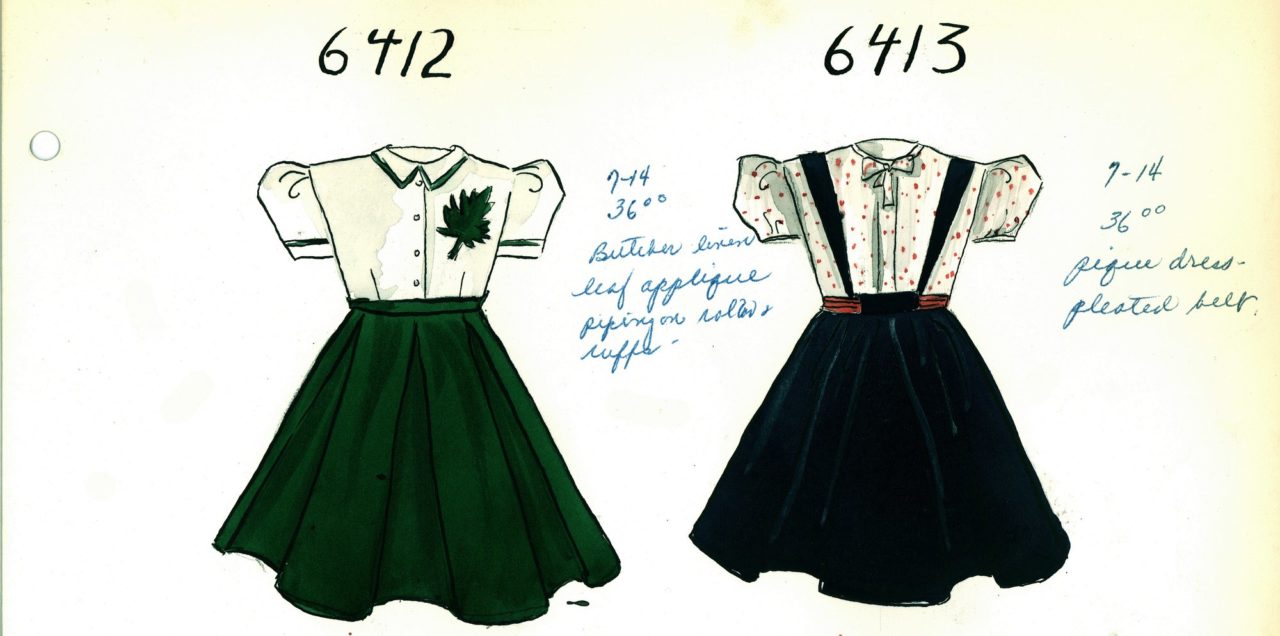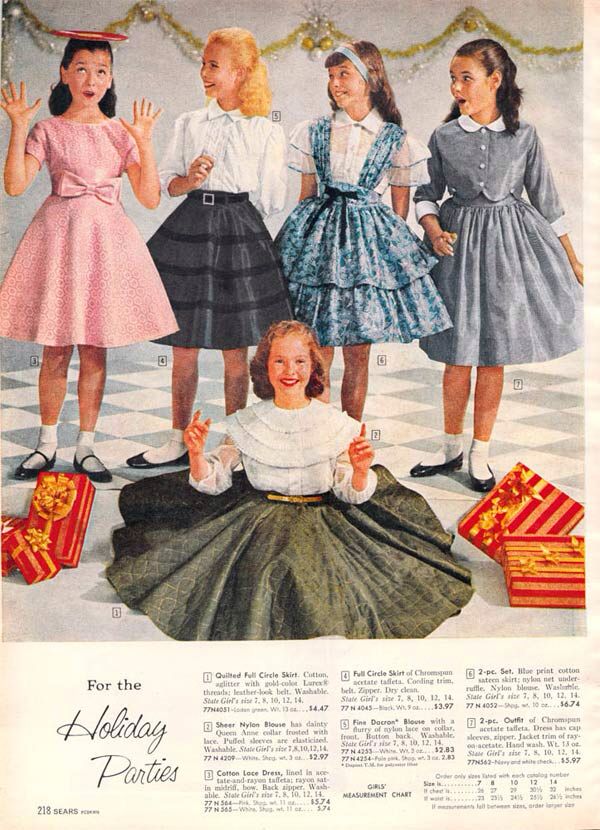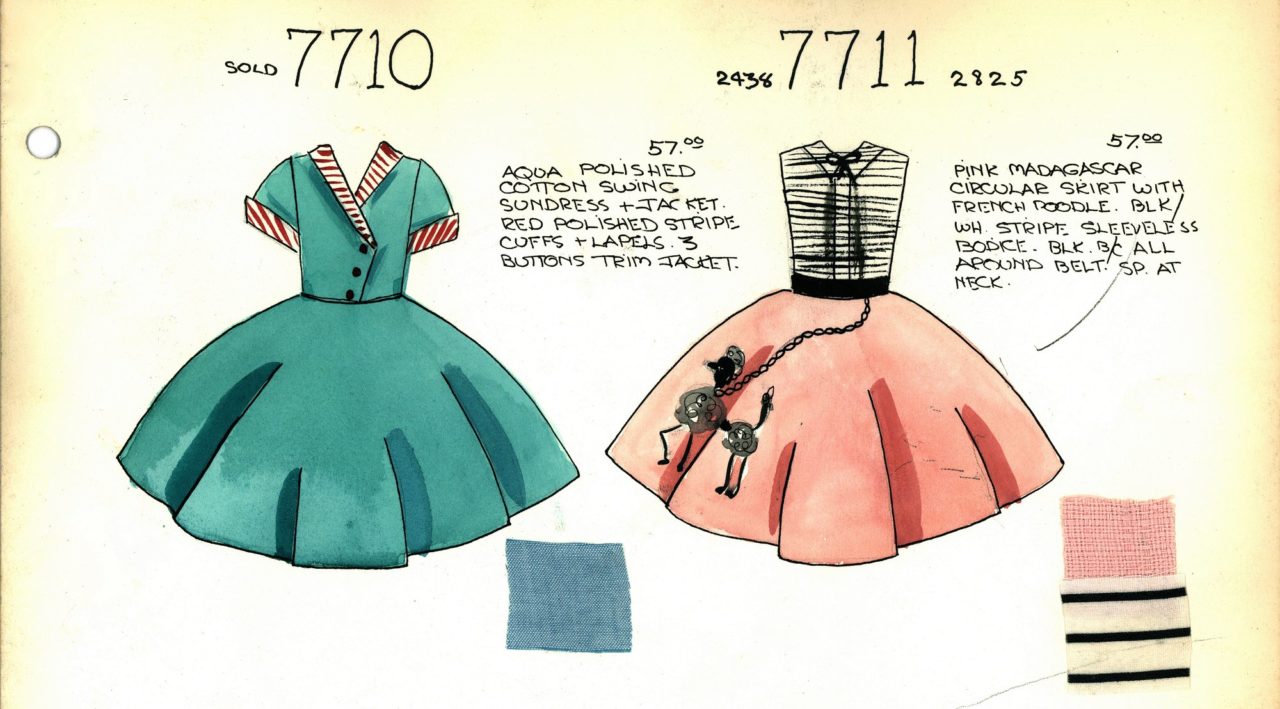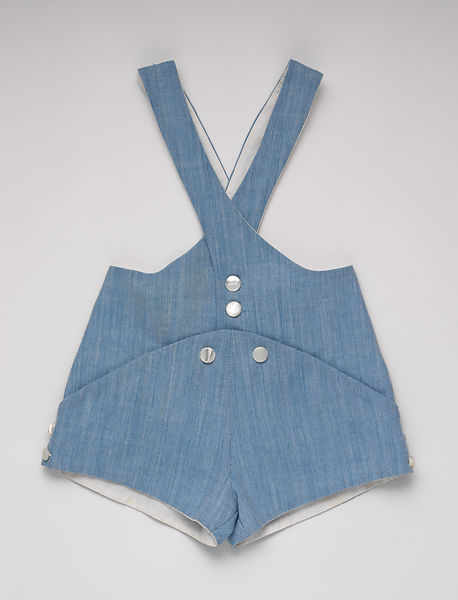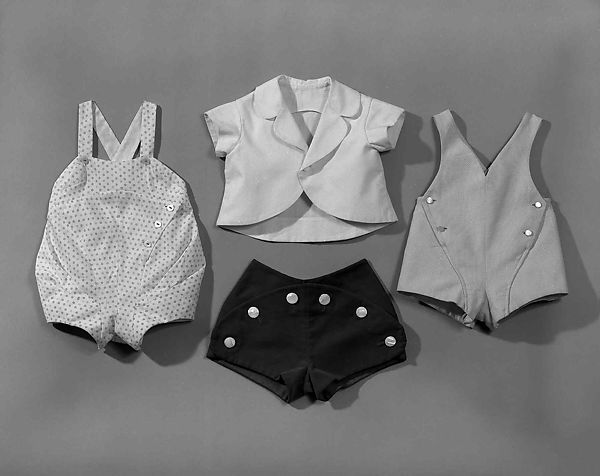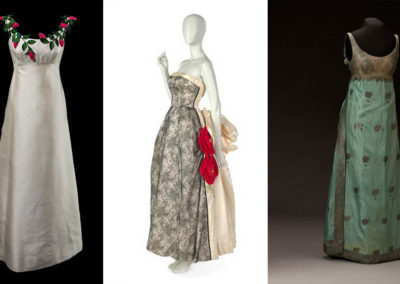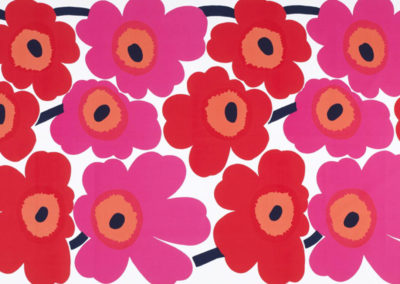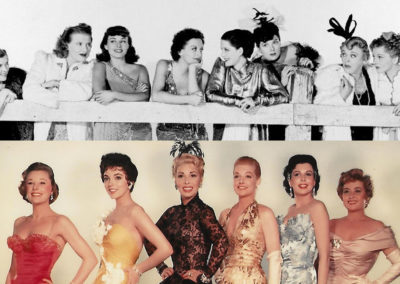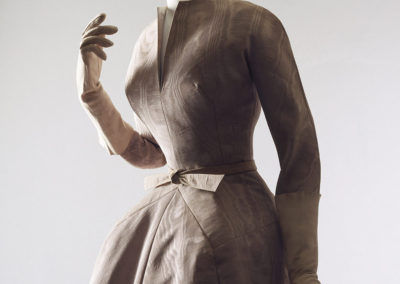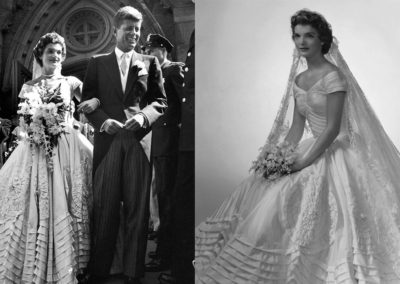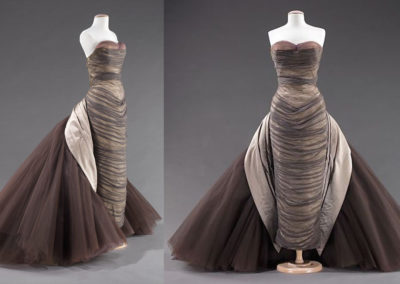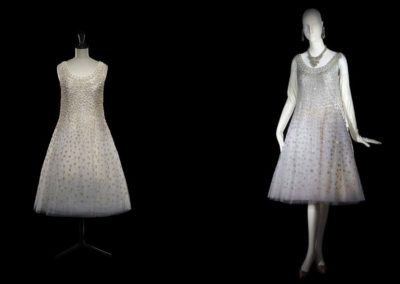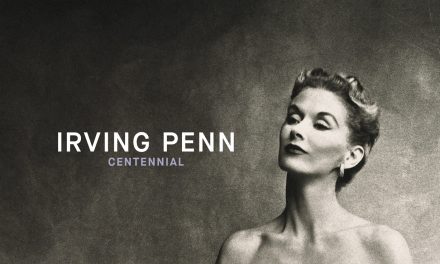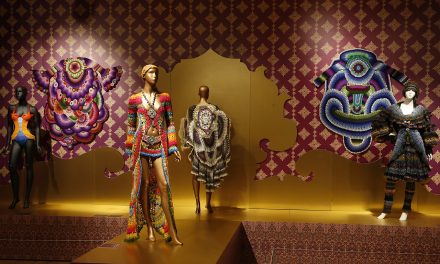OVERVIEW
Fashion in the 1950s saw a clear gender divide. While men and boy’s fashion moved towards a more casual day-to-day style, women and girl’s fashion prioritized elegance, formality, and perfectly matched accessories. Couture womenswear saw rapid change with new designers such as Cristobal Balenciaga and Hubert de Givenchy disrupting the overtly feminine silhouette popularized by Christian Dior while novel prints and colors marked a playfulness in fashion for both men and women.
Womenswear
Fashion is rarely contained neatly in one decade, and the popular look that dominated womenswear in the 1950s actually emerged in the late 1940s. When Christian Dior’s “New Look” appeared in February 1947, it became an instant success and the nipped-in waist and full-skirted silhouette remained the leading style until the mid-1950s. As the decade progressed, the dominant silhouette became progressively straighter and slimmer, and as fashion began to look to the new “teenager” for inspiration, the elegance and formality of the early part of the decade began to lessen.
As the 1950s began, the initial resistance to the extravagance of the New Look had died down and the silhouette was entrenched in both women’s daywear and eveningwear. Dior himself continued to produce designs that followed the feminine line even while incorporating new elements, like the structural collar seen in figure 1. While this shape remained popular until at least 1954, in his Fashion Sourcebooks: The 1950s, John Peacock describes how this figure evolved throughout the decade:
“from the comparatively early days of the ‘New Look,’ when the square shoulders and masculine details of the 1940s still lingered, through the ultra-feminine and luxurious styles of the mid-1950s – clothes with gently softened shoulderlines, tiny corseted waists, roundly padded hips and long, swirling skirts only eleven inches above the ground” (7).
Even as the silhouette evolved, its core style was seen in evening gowns, day dresses, and separates. A Givenchy dress from 1953 shows how the shape was restyled throughout the decade while remaining true to the nipped-in waist and full skirt (Fig. 3). The pea motif, along with the bright patterned dresses in Better Living magazine (Fig. 2), demonstrates a playfulness that emerged in pattern while the Charles James “Clover Leaf” dress (Fig. 4) and Balenciaga evening dress (Fig. 5) show the experimentation in construction that took place in the fifties.
Fig. 1 - Christian Dior (French, 1905–1957). New-York, 1950-51. Wool. New York: Brooklyn Museum Costume Collection at The Metropolitan Museum of Art, 2009.300.299. Gift of the Brooklyn Museum, 2009; Gift of Jeanne Eddy, 1961. Source: The Metropolitan Museum of Art
Fig. 2 - Better Living. There's News in Print, 1952. Classic Film. Source: Flickr
Fig. 3 - Hubert de Givenchy (French, 1927–2018). Dress, 1953. Linen. New York: Brooklyn Museum Costume Collection at The Metropolitan Museum of Art, 2009.300.913a, b. Gift of the Brooklyn Museum, 2009; Gift of Lauren Bacall, 1967. Source: The Metropolitan Museum of Art
Fig. 4 - Charles James (American, 1906–1978). Clover Leaf, 1953. Silk, silk/rayon. New York: The Metropolitan Museum of Art, C.I.53.73. Gift of Elizabeth Fairall, 1953. Source: The Metropolitan Museum of Art
Fig. 5 - Cristobal Balenciaga (Spanish, 1895–1972). Evening dress, 1951. Silk. New York: The Metropolitan Museum of Art, 1993.393.1. Gift of Gina Gerardo, 1993. Source: The Metropolitan Museum of Art
However, while the look was ubiquitous, it was not the only look that rose to prominence in the fifties. In fact, fashion curator Daniel Milford-Cottam writes in Fashion in the 1950s:
“One particularly striking aspect of the decade was the emergence of stylish options. Two ladies could walk down the street in different outfits, yet appear equally modish, be their skirts full and narrow, or one in a form-fitting sheath and the other in a loose sack dress.” (13)
He continues to explain that the idea of choice rather than following one specific style was relatively new in the 1950s. As the decade continued, these choices became varied as new designers such as Cristobal Balenciaga, Charles James, and Hubert de Givenchy introduced different silhouettes. In Costume and Fashion: A Concise History, James Laver writes, “As the decade progressed, clothing became less structured and straighter in cut” (258). Introduced by Chanel, Dior, and Balenciaga around the same time, the straight-cut suit, in contrast to the New Look, emphasized a woman’s natural shape with the jacket hanging at the widest point of the hips, as seen in figure 6. In the latter half of the decade, sheaths – like the Givenchy suit in figure 8 – and high-waisted chemise dresses, introduced by Balenciaga in 1957, became popular. The Balenciaga suit worn by model Suzy Parker (Fig. 7) shows the swing outline that he favored.
While designers such as Dior, Balenciaga, and Charles James created beautiful couture pieces, the craze for sportswear continued. Claire McCardell, the American designer who rose to prominence in the 1940s, continued to produce her popular wrap-over dresses and also introduced pedal-pushers with matching tops (Laver 258). While overall, fashion in the 1950s prided elegance, young women turned to McCardell and other sportswear and less formal designs, like the sundress and swimsuit in figure 10. Perhaps one of the most enduring images of everyday fashion in the fifties is the “poodle skirt.” Credited to Juli Lynne Charlot from California, these simple felt skirts were cut in a circle and could have any sort of embellishment, not just a poodle (Milford-Cottam 20). They were paired with tight-knitted twinsets and while much more casual than the haute couture coming out of Paris, these skirts still followed the line of the New Look with a defined waist and full skirt as seen in figure 9.
Fig. 6 - Gabrielle Chanel (French, 1883–1971). Suit, ca. 1957. Wool. New York: The Metropolitan Museum of Art, 1976.370.2a–c. Gift of Mrs. Stephane Groueff, 1976. Source: The Metropolitan Museum of Art
Fig. 7 - Louise Dahl-Wolfe (American, 1895-1989). Suzy Parker in Cristóbal Balenciaga, 1953. Kristine. Source: Flickr
Fig. 8 - Hubert de Givenchy (French, 1927–2018). Ensemble, 1958. Wool. New York: Brooklyn Museum Costume Collection at The Metropolitan Museum of Art, 2009.300.842a, b. Gift of the Brooklyn Museum, 2009; Gift of Mrs. William Randolph Hearst, Jr., 1960. Source: The Metropolitan Museum of Art
Fig. 9 - Photographer unknown. Ladies of Vinyl, ca. 1950s. Source: Pinterest
Fig. 10 - Carolyn Schnurer (American, 1908–1998). The Hakama dress, 1952. Cotton. New York: Brooklyn Museum Costume Collection at The Metropolitan Museum of Art, 2009.300.3141. Gift of the Brooklyn Museum, 2009; Gift of Carolyn Schnurer, 1952. Source: The Metropolitan Museum of Art
Fig. 11 - Cristobal Balenciaga (Spanish, 1895–1972). Cristóbal Balenciaga, 1957. Kristine. Source: Flickr
Fig. 12 - Gabrielle Chanel (French, 1883–1971). Shoes, ca. 1959. Leather, metal. New York: The Metropolitan Museum of Art, 2004.333.23a, b. Gift of Bradford Dillman, 2004. Source: The Metropolitan Museum of Art
Though it became increasingly acceptable for women to wear slacks for some occasions, overall the fashion mood in the fifties leaned towards femininity and formality. This was especially true in eveningwear as the cocktail dress was introduced to the public. Worn to the new cocktail party, these dresses lay in-between daywear and evening gowns, falling at the length of a day dress but embellished like eveningwear (Fig. 11). For formal eveningwear, even as sheaths and form-fitting dresses became popular, the full-skirted dress remained the mode throughout the decade, like the highly embellished evening gown by Dior in figure 13. The relatively new strapless bodice was especially popular as the pared-down bodice balanced out the wide skirts.
No matter what time of day, throughout the decade, it was exceedingly important that a woman be impeccably turned out. This meant perfectly groomed hair, spotless makeup, and sets of matching accessories. This was encouraged through the glamorous fashion photography of the day (Fig. 14). Fashion historian Gerda Buxbaum writes in Icons of Fashion: The 20th Century, “The long years of deprivation during World War II brought forth a yearning for luxury and fashionable things, and women made a special effort to dress appropriately for every occasion; it was considered imperative that one’s accessories matched perfectly” (69). Whether she was wearing a twinset and slacks, a poodle skirt, a sheath dress, or one of Dior’s New Look styles, a woman did her best to ensure that she looked pulled together through her accessories and overall styling. Those infamous black-toed Chanel shoes (Fig.12) appeared at the end of this decade, after all.
Fig. 13 - Christian Dior (French, 1905–1957). May, Spring/Summer 1953. Silk. New York: The Metropolitan Museum of Art, C.I.60.21.1a, b. Gift of Mrs. David Kluger, 1960. Source: The Metropolitan Museum of Art
Fig. 14 - Irving Penn (American, 1917–2009). Balenciaga Mantle Coat (Lisa Fonssagrives-Penn), Paris, 1950, printed 1988. Platinum-palladium print; 66.2 x 55.9 cm (26 1/16 x 22 in). New York: The Metropolitan Museum of Art, L.2018.62.8. Promised Gift of The Irving Penn Foundation. Source: The Metropolitan Museum of Art
Fashion Icon: James Dean
Fig. 21 - Warner Bros. Publicity still of James Dean for the film Rebel Without a Cause, 1955. Source: Wikimedia
Fig. 22 - Warner Bros. Cropped screenshot of James Dean and Natalie Wood in the trailer for the film Rebel Without a Cause, 1955. Trailer screenshot [Public domain]. Source: Wikimedia
Though he lived an astonishingly short life, James Dean had an undeniable influence on men’s fashion in the 1950s. Starring in only three movies within one year, Dean was killed in a car accident at the age of 24 in 1955. But his portrayal of Jim Stark in Rebel Without a Cause (Figs. 21-22) left an indelible mark of men’s fashion. Released after his death, Dean’s uniform of a white t-shirt, jeans, and red jacket was easily and readily copied.
Despite his short career in film, the popularity of his Rebel Without a Cause character struck a chord with the new generation of young men. The Encyclopaedia Britannica writes:
“His character defiantly rejects the values of his elders while desperately aching to ‘belong’ and attempting to find a purpose in life. Dean’s performance spoke eloquently on behalf of disenchanted, disenfranchised teenagers and gave them a hero they could respect and admire.”
This hero status, along with similar feelings towards fellow actor Marlon Brando’s characters in A Streetcar Named Desire and The Wild One, influenced young men’s fashion as they emulated these characters (Buxbaum 77). Together, Dean and Brando ensured the rise of the white t-shirt, jeans, and greased back hair that was pervasive throughout the 1950s.
Menswear
Although womenswear in the 1950s prided formality, men’s fashion moved towards an informality it had not yet seen before. Though young women wore tight sweaters and sought clothes that suited her age, it was young men who really started the so-called “youth culture” of the 1950s. Since the rise of the suit in the 18th century, men’s fashion had seen little dramatic change until the rise of the Teddy Boys in Britain and the rebellious youths who looked to Hollywood stars Marlon Brando and James Dean in the fifties. Significantly, both of these styles were adopted or inspired by working-class men, rather than coming from the elite.
In the years after World War II, tailors on Savile Row in London introduced a slim cut suit with a velvet-collared suit that was referred to as the New Edwardian (Milford-Cottam 53). While it was originally elegant, upper-class men who wore these suits with narrow trousers, in the early 1950s, young working-class men began to adopt and adapt the style for their own purposes. Nicknamed “Teddy Boys” (Teddy being a nickname of Edward), these young men, seen in figure 15, wore extremely narrow trousers, velvet-collared jackets and greased their hair back into quiffs. While the style was popular and signified a certain type of rebellious young working-class man, it also signified a shift in the ability of the working-class young to consume. Laver writes:
“What was important in this development was not the adoption by the working class of an upper-class style, but the fact that young men from poor backgrounds could now afford relatively expensive clothes and accessories and had the confidence to make them part of their own distinctive style.” (260)
The Teddy Boys were just one part of a rise in youth culture that was seen across both genders and on both sides of the pond.
Fig. 17 - Photographer unknown. Marlon Brando - The Wild One, 1955. Ur Cameras. Source: Flickr
Fig. 18 - Photographer unknown. Elvis Presley in Jailhouse Rock., 1957. The Library of Congress. Metro-Goldwyn-Mayer, Inc. Reproduction Number: LC-USZ6-2067. Source: Wikimedia
Even as young men in both Europe and the United States began adopting new styles, formal daywear and eveningwear for men continued along the same lines throughout the 1950s. Suits maintained the baggy shape that had started in the forties, while skinny ties, like the one in figure 19, rose to prominence. The biggest change in men’s formal wear was the increasing presence of color, as seen in the ad for the bright yellow Arrow shirt (Fig. 20). Tuxedo accessories such as ties and cummerbunds added a pop of color, while less formal eveningwear such as the smoking jacket might come in a color other than black. Color began to creep into daywear shirts and sweaters, as well (Milford-Cottam 48-51). The Hawaiian shirt, first seen in the late forties, continued to be a popular option for men throughout the fifties.
CHILDREN’S WEAR
Children’s fashion in the 1950s echoed the trends found in their adult counterparts. Young girls wore dresses with full skirts and perfectly matching accessories while young boys saw their clothing options becoming more casual. New synthetic materials, which were also being used in adult clothing, were increasingly used for children’s clothes as they were easier to launder.
In previous decades, young boys had typically worn collared shirts, ties, blazers, and shorts until they were old enough to transition to long trousers. However, in the 1950s, like teenagers and young men, it became increasingly acceptable for boys to wear jeans for most occasions. It became rare throughout the decade for young boys to wear ties and collared shirts were abandoned in the most casual settings. Colorful and patterned short-sleeved, collared shirts were popular options for everyday wear (Fig. 23). Knitted sweaters and cardigans, popular in the forties, continued to be popular in the fifties as it became less common for young boys to wear jackets or blazers. SJ Stratford writes on Love to Know, “Although conformity was the guiding principle for everyone’s dress, boys were able to enjoy a level of comfort and casualness that they hadn’t before and that girls would not share for another few decades.”
Fig. 23 - Sears. Sears Catalog Highlights, Spring/Summer 1958. Source: The Man in the Gray Flannel Suit
Fig. 24 - Joseph Love (American, 1891?-1971). Girl's Dresses, 1950. Gouache, ink; (7.5 x 11 in). New York: Joseph Love, Inc.. Source: SPARC Digital
Fig. 25 - Joseph Love (American, 1891?-1971). Girl's Skirt Sets and Slacks, 1955. Gouache, ink; (5 x 11 in). New York: Joseph Love, Inc.. Source: SPARC Digital
Dropped waists (still with full skirts, like that in figure 25), smock dresses, pinafores, bold colors, and playful patterns all offered different styles. For less formal occasions, girls might wear a blouse and full skirt held up with suspenders (as seen on the right in figure 24) and covered in a matching jacket or cardigan. Novelty items like the poodle skirt (Fig. 28) were also popular, while sheath dresses and slacks became acceptable options later in the decade. Stripes, florals, plaids, rickrack (Fig. 27), bows, and more could all be found embellishing girls’ clothes. Whether at a party or at school, these looks were almost always accompanied by white ankle socks and shiny black patent leather shoes and carefully styled hair perhaps adorned with a ribbon or two bows, as evidenced in the Sears ad in figure 26. At home, girls might have worn overalls or playsuits in casual settings.
Fig. 26 - Sears. For the Holiday Parties, 1959. Source: Pinterest
Fig. 27 - Joseph Love (American, 1891?-1971). Girl's Dresses, 1953. Gouache, ink; (7.5 x 11 in). New York: Joseph Love, Inc.. Source: SPARC Digital
Fig. 28 - Joseph Love (American, 1891?-1971). Girl's Dresses, 1953. Gouache, ink; (7.5 x 11 in). New York: Joseph Love, Inc.. Source: SPARC Digital
Fig. 29 - Charles James (American, 1906–1978). Playsuit, 1956. Cotton, mother-of-pearl, metal. New York: The Metropolitan Museum of Art, 2018.137.2. Gift of Janelle and Charles E. Whalen, Jr., 2018. Source: The Metropolitan Museum of Art
Upon becoming a father himself, womenswear designer Charles James designed a line of infant clothes in 1956. The cotton playsuits, shorts, and dresses were simple yet finished with beautiful mother-of-pearl buttons and other luxurious touches (Fig. 30). But what made the line significant was its construction, as seen in the multi-piece sunsuit on the left in figure 31. The Met writes of the blue playsuit in Fig. 29:
“James considered all practicalities, designing this playsuit with curved, crossing straps, cut in one with the front panels, that fit to the body and stay in place, and with diaper-front shorts that open to lay flat for ease of ironing. Its curved fronts follow the lines of a child’s rounded belly, while accommodating and hiding the bumps of diapers” (Playsuit, 1956).
The classic pieces come in reds and blues, show subtle nautical inspiration, and give a glimpse into luxury infant pieces from the decade.
Fig. 30 - Charles James (American, 1906–1978). Coat, 1956. Wool, cotton. New York: Brooklyn Museum Costume Collection at The Metropolitan Museum of Art, 2009.300.3580. Gift of the Brooklyn Museum, 2009; Gift of Mrs. John de Menil, 1957. Source: The Metropolitan Museum of Art
Fig. 31 - Charles James (American, 1906–1978). Sunsuit, 1956. Cotton. New York: Brooklyn Museum Costume Collection at The Metropolitan Museum of Art, 2009.300.3579. Gift of the Brooklyn Museum, 2009; Gift of Mrs. John de Menil, 1957. Source: The Metropolitan Museum of Art
References:
- Bramlett, Lizzie. “Interview with Juli Lynne Charlott.” The Vintage Traveler, April 28, 2010. Accessed May 29, 2019. https://thevintagetraveler.wordpress.com/2010/04/28/interview-with-juli-lynne-charlot/.
- Buxbaum, Gerda. Icons of Fashion: The 20thCentury. Munich: Prestel Verlag, 2005. http://www.worldcat.org/oclc/773599428.
- “James Dean.” Encyclopaedia Britannica. Accessed May 29, 2019. https://www.britannica.com/biography/James-Dean-American-actor.
- Ewing, Elizabeth. History of 20thCentury Fashion. 4th ed. London: B.T. Batsford Ltd, 2001. http://www.worldcat.org/oclc/456545252.
- James Dean. “Biography.” Accessed May 29, 2019. https://www.jamesdean.com/biography/.
- Laver, James, Amy De La Haye and Andrew Tucker. Costume and Fashion: A Concise History.5th ed. New York: Thames & Hudson, 2012. http://www.worldcat.org/oclc/966352776.
- The Met. “Playsuit, 1956.” Accessed May 29, 2019. https://www.metmuseum.org/art/collection/search/767965.
- Milford-Cottam, Daniel. Fashion in the 1950s. Oxford: Shire Publishing, 2017. http://www.worldcat.org/oclc/992690449.
- Peacock, John. Fashion Sourcebooks: The 1950s. London: Thames and Hudson Ltd, 1997. http://www.worldcat.org/oclc/924866505.
- The People History. “Vintage 1950s Children’s Fashion Clothes.” Accessed May 29, 2019. http://www.thepeoplehistory.com/1950skidsfashion.html.
- Stratford, SJ. “1950s Kids Clothing.” Love to Know. Accessed May 29, 2019. https://childrens-clothing.lovetoknow.com/1950s_Kids_Clothing.
- Victoria and Albert Museum. “History of Fashion 1900 – 1970.” Accessed April 30, 2019. http://www.vam.ac.uk/content/articles/h/history-of-fashion-1900-1970/.
- Victoria and Albert Museum. “Introduction to 20thCentury Fashion.” Accessed April 30, 2019. http://www.vam.ac.uk/content/articles/i/introduction-to-20th-century-fashion/.
Historical Context
Wikipedia: 1950-1959
Events:
- 1950 – Father of the Bride, starring Spencer Tracy and Elizabeth Taylor, is released. The lace wedding dress worn by Taylor in the movie is considered one of her most iconic books.
- 1951 – American disc jockey Alan Freed popularizes the term “Rock ‘n’ roll.” New teen styles emerge linked to the music, such as “Teddy boys” and prom dresses.
- 1952 – Jack Kerouac publishes On the Road, which inspires a generation of beatniks who wear slim-fitting, black clothes, berets, and dark glasses. Audrey Hepburn’s Funny Face in 1957 further popularizes the style. Balenciaga shows the sack dress, an early stylistic move toward looser-fitting garments, which appear in the late 1950s and 60s, and include cocoon coats and shift dresses.
- 1953 – Coronation of Queen Elizabeth II, and London couturiers including John Cavanagh, Victor Stiebel, and Mattli make ball gowns for guests at coronation balls and dances. The Wild One is released; Marlon Brando’s representation of disaffected youth popularizes blue jeans and leather jackets. Pierre Cardin shows his first collection in Paris.
- 1954 – Easy-to-wash and easy-to-dry nylon twin sets advertised in British Vogue fashion magazine.
- 1955 – Rebel Without a Cause is released, launching its star, James Dean, as a style icon for the rising youth culture. His death a year later cements his legendary status. Stiletto heels are popular by the mid- 1950s aided by new technology. Ultra-thin, ultra-high steel heels could sustain great pressure in comparison to wood heels. Mary Quant opens her influential store, Bazaar, in London.
- 1956 – Movie star Grace Kelly marries Prince Rainier of Monaco in a religious ceremony, wearing a lace wedding dress designed by Helen Rose.
- 1957 – Jailhouse Rock, starring Elvis Presley, marks the spread of rock- and-roll style.
- 1958 – The youthful Yves Saint Laurent shows his first collection at Dior- Trapeze- after Dior’s death in 1957.
- 1959 – Debut of Barbie doll, marketed as a “Teen-age Fashion Model.” Lycra, also known as spandex or elastane, is invented. It revolutionizes performance sportswear and then fashionable dress.
Timeline Entries
Primary/Period Sources
Resources for Fashion History Research
To discover primary/period sources, explore the categories below.
Have a primary source to suggest? Or a newly digitized periodical/book to announce? Contact us!
Periodicals (Digitized)
Filmography
Secondary Sources
Also see the 20th-century overview page for more research sources... or browse our Zotero library.
Online
Books/Articles


